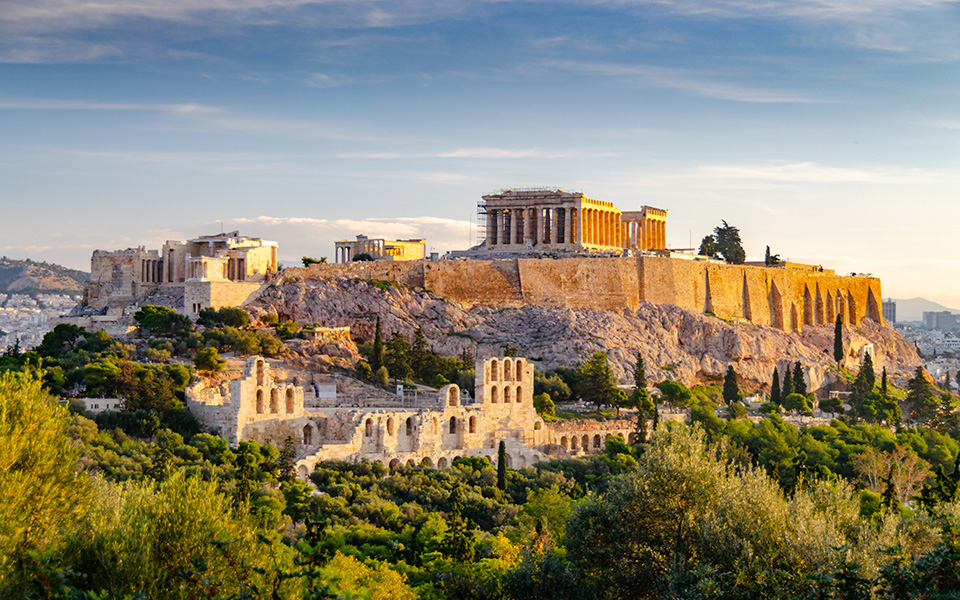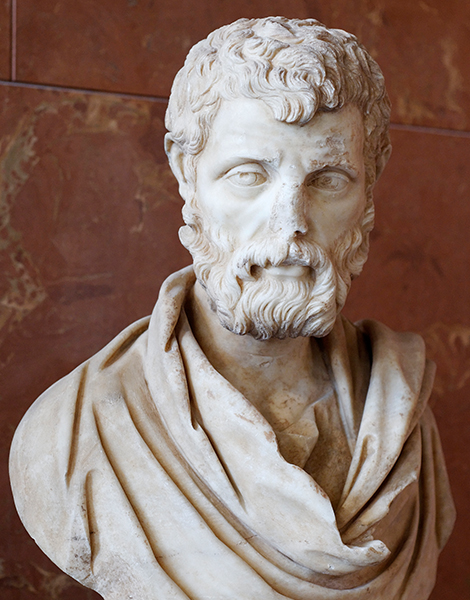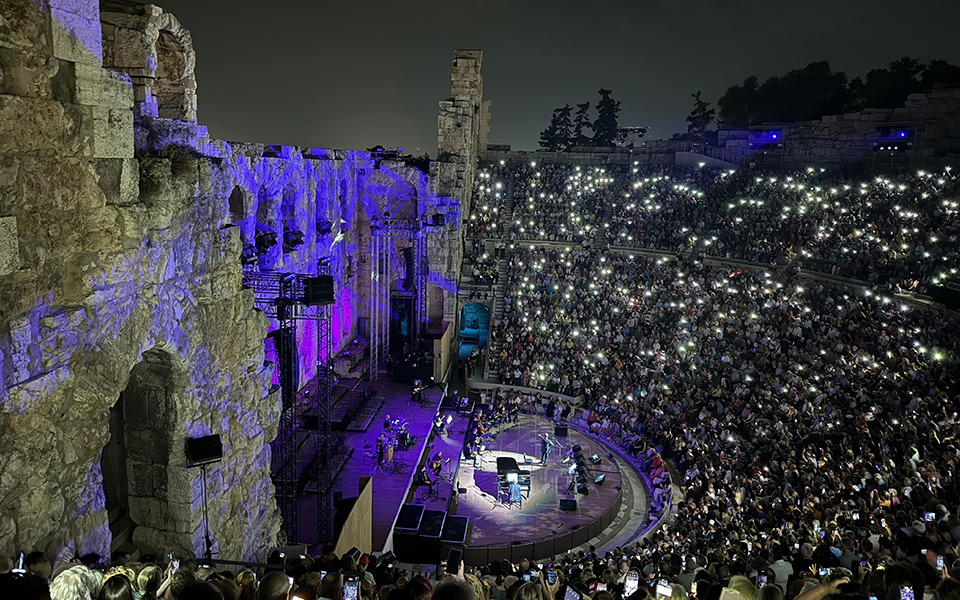As dusk settles over Athens, the cicadas strike up their familiar, hypnotic chorus. Along the cobbled promenade of Dionysiou Areopagitou, street musicians tune their instruments, families wander past neoclassical façades, and the golden light on the Acropolis fades into a soft, silvery glow. For a moment, it feels like the Athens of another age.
Below the mighty Parthenon, something stirs. Music – amplified not by speakers, but by ancient stone – rises gently into the warm evening air. An operatic cantata, or perhaps a full symphony orchestra, plays under the stars to an audience of thousands, seated in sweeping rows of Pentelic marble. This is the Odeon of Herodes Atticus: ancient, yet alive. A Roman theater nearly 1,900 years old, reborn as one of the world’s most evocative performance spaces.
 Located on the southwest slope of the Acropolis of Athens, the Odeon of Herodes Atticus was built in AD 161 by the prominent Athenian nobleman and philanthropist Herodes Atticus (c. 101-177 AD).
Located on the southwest slope of the Acropolis of Athens, the Odeon of Herodes Atticus was built in AD 161 by the prominent Athenian nobleman and philanthropist Herodes Atticus (c. 101-177 AD). © Shutterstock
Located on the southwest slope of the Acropolis of Athens, the Odeon of Herodes Atticus was built in AD 161 by the prominent Athenian nobleman and philanthropist Herodes Atticus (c. 101-177 AD).© Shutterstock
Tucked into the southwest slope of the Acropolis, just steps from the Theater of Dionysus, the Odeon is visible to all who ascend the Sacred Rock. Yet few pause to ask who built it – or why. Its arcaded façade blends into the archaeological landscape so seamlessly that its story is often overlooked.
This is the tale of a monument that has witnessed empire, centuries of abandonment, and a spectacular modern renaissance – and of the enigmatic figure behind its creation. Herodes Atticus, Athenian aristocrat and Roman senator, was among antiquity’s most prolific benefactors. But he was also a man shadowed by scandal, rumored to be complicit in a dark family tragedy. Set against the backdrop of an extraordinary building campaign, his gift to Athens was a conspicuous display of public devotion – and perhaps a reckoning with personal grief.
 The Arch of Hadrian commemorates the rebirth of the city by the philhellenic emperor Hadrian (r. AD 117-138). An inscription on the northwest side of the arch, facing towards the Acropolis, refers to the "city of Theseus."
The Arch of Hadrian commemorates the rebirth of the city by the philhellenic emperor Hadrian (r. AD 117-138). An inscription on the northwest side of the arch, facing towards the Acropolis, refers to the "city of Theseus." © Shutterstock
The Arch of Hadrian commemorates the rebirth of the city by the philhellenic emperor Hadrian (r. AD 117-138). An inscription on the northwest side of the arch, facing towards the Acropolis, refers to the "city of Theseus."© Shutterstock
Athens Under Roman Rule: A City Remade
By the time emperor Hadrian came to power in the early second century AD, Athens was no longer the democratic powerhouse of the Classical age. But it remained steeped in intellectual prestige – a living museum of philosophy, rhetoric, and ancestral glory. Hadrian, one of Rome’s most erudite rulers and an unabashed philhellene, saw in Athens not a relic but a canvas: a legacy to be renewed. With tireless ambition, he set about expanding and embellishing it, restoring the city of Theseus and of Pericles to its rightful place of prominence on the imperial map.
During his reign (AD 117–138), Athens experienced a kind of second birth. New temples, stoas, libraries, and public fountains sprang up across the city. Most ambitious of all was the colossal Olympieion – the Temple of Olympian Zeus – which Hadrian completed after more than six centuries of delay (construction had begun in the 6th century BC but was long abandoned). Nearby, he erected a monumental arch bearing a pointed inscription:
 
“This is Athens, the city of Theseus / This is the city of Hadrian, not of Theseus.”
The message was clear: this was now a Roman Athens, reshaped through imperial vision yet anchored in Greek heritage.
 The Odeon (Herodeion) was originally a steep-sloped theatre with a three-story stone front wall and a wooden roof made of cedar, imported from Lebanon.
The Odeon (Herodeion) was originally a steep-sloped theatre with a three-story stone front wall and a wooden roof made of cedar, imported from Lebanon. © Shutterstock
The Odeon (Herodeion) was originally a steep-sloped theatre with a three-story stone front wall and a wooden roof made of cedar, imported from Lebanon.© Shutterstock
Hadrian’s largesse stood in stark contrast to the trauma Athens had endured two centuries earlier. In 87 BC, the Roman general Sulla besieged the city during the First Mithridatic War, crushing a rebellion against Roman authority with brutal efficiency. The monuments of the Acropolis were spared, but the city itself was sacked – blood reportedly flowed through its streets – and Athens entered a long decline. Hadrian’s building campaign, along with the patronage of elite Athenians like Herodes Atticus, was part of a broader revival: an effort to restore the cultural and civic vitality of the ancient city.
The Odeon of Herodes Atticus, built just decades after Hadrian’s death, emerged from this same spirit of renewal. Roman in form but Greek in function, it was intended for music, oratory, and poetic performance – a stage for cultivated sound, not gladiatorial spectacle. Its vaulted interior and cedar-wood roof, sourced from Lebanon, embodied Roman engineering, while its purpose hearkened back to the traditions of the Greek stage.
 
Rising at the foot of the Acropolis, the Odeon was more than a venue: it was a public declaration, a bridge between the great civilizations of Greece and Rome, and a monument designed to endure.
 Marble bust of Herodes Atticus, c. AD 161. Found in Probalinthos, Attica. On display in the Louvre, Paris.
Marble bust of Herodes Atticus, c. AD 161. Found in Probalinthos, Attica. On display in the Louvre, Paris.
Marble bust of Herodes Atticus, c. AD 161. Found in Probalinthos, Attica. On display in the Louvre, Paris.
Marble bust of Herodes Atticus, c. AD 161. Found in Probalinthos, Attica. On display in the Louvre, Paris.
 Herodes Atticus commissioned the stone theater in memory of his late wife, Aspasia Annia Regilla, whose death the previous year is shrouded in mystery.
Herodes Atticus commissioned the stone theater in memory of his late wife, Aspasia Annia Regilla, whose death the previous year is shrouded in mystery. © Shutterstock
Herodes Atticus commissioned the stone theater in memory of his late wife, Aspasia Annia Regilla, whose death the previous year is shrouded in mystery.© Shutterstock
Herodes Atticus: Athens’ Philanthropist or Powerbroker?
Completed around AD 161, the Odeon (otherwise known as the “Herodeion”) was dedicated to the memory of his wife, Appia Annia Regilla – a Roman noblewoman of renowned Annia gens (family), related to several emperors, a priestess of Demeter, and mother of six. Yet like much of Herodes’ life, the monument hovers between public generosity and private shadow. Even Pausanias, the second-century Greek traveler and geographer, took note of the Odeon’s significance, calling it a “remarkable” building … “second to none of those which we know in size and in the harmony of its proportions” (Description of Greece 1.21.13).
Born into immense wealth in Marathon around AD 101, Herodes belonged to a lineage of Athenian aristocrats long allied with Rome. His full name – Lucius Vibullius Hipparchus Tiberius Claudius Atticus Herodes – echoed with imperial prestige, signaling both elite Greek heritage and Roman senatorial authority. Trained in rhetoric and philosophy, he rose to fame as a celebrated speaker in Athens and Rome, eventually becoming tutor to the future emperors Marcus Aurelius and Lucius Verus.
 The nymphaeum (monumental fountain) of Herodes Atticus and Regilla in Olympia. As a member of the prominent gens Annia in Rome, Herodes' wife Appia was related to the imperial family of Marcus Aurelius.
The nymphaeum (monumental fountain) of Herodes Atticus and Regilla in Olympia. As a member of the prominent gens Annia in Rome, Herodes' wife Appia was related to the imperial family of Marcus Aurelius.
The nymphaeum (monumental fountain) of Herodes Atticus and Regilla in Olympia. As a member of the prominent gens Annia in Rome, Herodes' wife Appia was related to the imperial family of Marcus Aurelius.
The nymphaeum (monumental fountain) of Herodes Atticus and Regilla in Olympia. As a member of the prominent gens Annia in Rome, Herodes' wife Appia was related to the imperial family of Marcus Aurelius.
His renown was matched by his enormous fortune. The family estate encompassed vast landholdings in Greece and Italy, and Herodes channeled his wealth into an extraordinary array of public works: a theater at Corinth, a stadium at Delphi, the monumental nymphaeum (fountain) at Olympia (also dedicated to his wife); the Panathenaic Stadium in Athens; aqueducts, baths, temples. As Philostratus observed in his Lives of the Sophists, Herodes “did not leave any city in Greece without giving it some evidence of his wealth.” (Sophist. 2.1.6).
Yet none of these projects carried the emotional weight of the Odeon – built in marble, but born, perhaps, of guilt.
 
In AD 160, Appia Regilla died under deeply suspicious circumstances while eight months pregnant. Herodes’ freedman, Alcimedon, was accused of kicking her in the abdomen, causing premature labor. She bled to death, and it was alleged that Alcimedon had acted on Herodes’ orders. He stood trial in Rome for first-degree murder of his wife and was acquitted, but doubts lingered. Regilla’s powerful brother, Appius Annius Atilius Bradua – a serving consul – pursued legal action, and the case came before the imperial court of none other than Marcus Aurelius.
No words survive from Regilla herself. But the Roman law on homicide offers a chilling reflection: “A man who strikes his pregnant wife, from which act she dies, is considered infamous as if he had committed homicide.” (Digest 48.8.1). Herodes, however, was ultimately exonerated.
Was the Odeon a tribute from a grieving man – or a calculated act of self-vindication? A personal eulogy made public?
 Tomb presumed to be that of Annia Regilla in Rome's Caffarella Park.
Tomb presumed to be that of Annia Regilla in Rome's Caffarella Park.
Tomb presumed to be that of Annia Regilla in Rome's Caffarella Park.
Tomb presumed to be that of Annia Regilla in Rome's Caffarella Park.
In many ways, Herodes was a forerunner of the modern philanthropist: a figure of immense means who reshaped public life through private wealth. Like today’s tech moguls – Bill Gates, Elon Musk, Jeff Bezos – his name was inscribed into the fabric of cities. But what do such gifts reveal about character? When does generosity serve the common good, and when does it mask ambition – or consolidate control?
Appia Regilla’s fate reminds us how delicate the boundary is between public image and private consequence. As a priestess of Demeter in Athens and a member of one of Rome’s most powerful families, she occupied a rarefied position in the imperial world – revered, visible, and yet, as a woman, profoundly vulnerable. Her silence in the record may be the most haunting absence of all.
 Odeon of Herodus Atticus, 1870-1880. Nicholas Catsimpoolas Collection, Boston Public Library
Odeon of Herodus Atticus, 1870-1880. Nicholas Catsimpoolas Collection, Boston Public Library
Odeon of Herodus Atticus, 1870-1880. Nicholas Catsimpoolas Collection, Boston Public Library
Odeon of Herodus Atticus, 1870-1880. Nicholas Catsimpoolas Collection, Boston Public Library
Destruction and Revival
Once the applause faded and Rome’s empire began to fracture, the Odeon of Herodes Atticus fell into silence. Like so many monuments of the Roman world, its fate was bound to that of the state – and in AD 267, that fate came violently undone. In a sudden and devastating raid, the Germanic tribe of the Heruli breached Athens’ walls and sacked its civic core. The Odeon, then barely a century old, was destroyed in the assault.
In the aftermath, performances ceased. Civic life contracted, and Athens – already diminished from its classical heights – withdrew behind a tighter circuit of fortifications. The once-proud structure was abandoned. Earthquakes followed. The cedar-wood roof collapsed. Tiered seating was stripped, repurposed for other buildings or burned in lime kilns. By the Middle Ages, only fragments remained, half-buried at the foot of the Acropolis.
 
Travelers in Ottoman-era Athens glimpsed little more than a ruined arcade, mistaken by some for the remains of a Roman bath. But by the 18th and 19th centuries, Romantic-era antiquarians and early archaeologists began documenting the site with growing interest. It wasn’t until the 1850s that systematic excavation revealed the theater’s full footprint. Still, the Odeon remained a ghost of its former self – a broken shell awaiting renewal.
 The Odeon of Herodes Atticus with the Parthenon in the background.
The Odeon of Herodes Atticus with the Parthenon in the background.
The Odeon of Herodes Atticus with the Parthenon in the background.
The Odeon of Herodes Atticus with the Parthenon in the background.
The turning point came in the 1950s. Under the direction of Greek architect Anastasios Orlandos, a major restoration campaign began. The “cavea” (seating area), orchestra, and stage were painstakingly rebuilt using Pentelic marble, in keeping with the ancient style. The goal was not just archaeological fidelity, but cultural revival. The Odeon, long silenced, would sing again.
Its rebirth, however, has not been without controversy. Some scholars question the reconstruction’s fidelity to Roman design; others caution against the wear of regular use and the fragile balance between access and preservation.
 
Still, few who sit beneath the Acropolis on a summer night would call it anything but extraordinary. Its semi-enclosed horseshoe shape, tiered stone seating, and precisely curved architecture give it an acoustic clarity that continues to astonish engineers and performers alike. Sound travels cleanly across its marble tiers without amplification; even a whisper on stage can be heard in the highest rows. The ancient design achieves what modern venues still strive for – intimacy on a grand scale.
Though it holds around 5,000 spectators, the space feels remarkably close. The proximity between audience and performer, the soft reflectivity of the limestone and marble, and the silent presence of the Acropolis overhead all contribute to an atmosphere that is both theatrical and transcendent. Artists often speak of the “energy” of the space – how the stone seems to breathe with the crowd.
 The Odeon of Herodes Atticus is one of the main performance venues of the renowned Athens Epidaurus Festival.
The Odeon of Herodes Atticus is one of the main performance venues of the renowned Athens Epidaurus Festival. © Shutterstock
The Odeon of Herodes Atticus is one of the main performance venues of the renowned Athens Epidaurus Festival.© Shutterstock
Since its return to life, the Odeon has hosted an extraordinary lineage of artists. Maria Callas gave some of her final concerts here in the late 1950s. Leonard Cohen, Frank Sinatra, Nana Mouskouri, Sting, Florence Welch, even the Greek symphonic death metal band Septicflesh have performed beneath the Acropolis. In 2024, Coldplay filmed the music video for their hit single “Feelslikeimfallinginlove” on its stage – a contemporary echo of ancient spectacle.
Each summer, the theater becomes the crown jewel of the famous Athens Epidaurus Festival – which celebrates its 70th anniversary in 2025 – a convergence of opera, music, theater, and contemporary performances beneath the Athenian moonlight.
 
In its second life, the Odeon invites us not only to remember antiquity – but to experience it, viscerally, as living history.

 1 month ago
66
1 month ago
66








 Greek (GR) ·
Greek (GR) ·  English (US) ·
English (US) ·